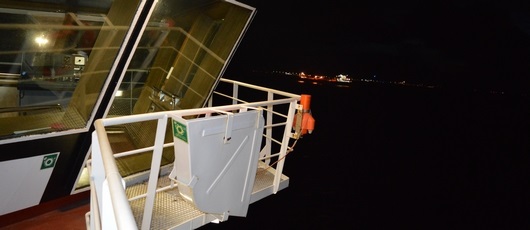Two Fatal Man Overboard Incidents Investigated
Two accident investigation reports published over the last week have highlighted the risks of falling overboard whilst undertaking routine tasks. In both cases, the men died despite rescue attempts by other crew members
Man overboard from Hyundai Dangjin
The Australian Transport Safety Bureau (ATSB) has issued its report on the man overboard incident on Hyundai Dangjin. On July 10, 2015, Hyundai Dangjin was in the final stages of loading its cargo of iron ore at Port Walcott, Western Australia. The ship was starboard side alongside the wharf and the chief mate and draught surveyor were on the wharf to check the ship’s draught. They could see the forward and aft draught marks but not the midships marks.
The chief mate asked the second mate, via UHF radio, to read the midships draught on the ship’s port (outboard) side. The ship’s crew had already rigged a rope ladder adjacent to the draught marks there.
In preparation to climb down the rope ladder, the second mate donned a life vest (non-inflatable flotation aid). The able seaman (AB) on duty offered to go down the ladder instead of the second mate, who was a large and heavy man. The second mate declined the AB’s offer (mates are trained to read draught marks).
Just after 0455, the chief mate and draught surveyor returned from the wharf to the ship’s office. The chief mate then called the second mate and asked for the midships draught. The second mate did not reply.
At that time, the second mate was near the bottom of the ladder, about seven meters below the ship’s deck. He called out to the AB for help and said he was having difficulty. When the AB checked, he saw the second mate struggling to hold on to the ladder. As the AB looked around for a rope to throw down, the second mate fell into the water. The AB threw a nearby lifebuoy to the second mate and it landed a few meters away.
The second mate tried to swim to the lifebuoy, but was not able to reach it. The sea was rough (1.4 m sea on a 0.4 m swell) and the water temperature was about 22 °C. The man was eventually retrieved from the water but did not respond to resuscitation attempts.
Safety message from the ATSB
In many cases, little attention is paid to planning apparently straightforward tasks, such as using a rope ladder. This can lead to important factors and relevant considerations not being taken into account, including the experience and physical ability of persons undertaking the task.
The full report is available here.
Man overboard from Selandia Swan
The Danish Maritime Accident Investigation Board has released its findings of a separate man overboard accident – that of Selandia Swan last year. The findings from the investigation have indicated that the third officer was inspecting the lifebuoys mounted on the bridge wings while he was alone on watch on the bridge. During the inspection of the starboard lifebuoy, he accidentally lost his footing and fell overboard.
Within 15 minutes the crewmembers realized that the thirrd officer was missing and they immediately responded as if he had fallen overboard and initiated the man overboard procedures. Several ships participated in the search, but were unsuccessful in locating him.
He was located and recovered by a rescue helicopter deployed from the Danish JRCC. Resuscitation was commenced immediately after he was recovered from the sea, but was not successful.
The accident was a result of an absence of clear instructions on how to go about inspecting the lifebuoy. In the absence of instruction or guidance, the man made a detailed inspection of the only item he could – namely the light. Neither the workplace nor the lifebuoy was designed for maintenance work. In order to carry out that inspection he had to climb the guard rail, thereby exposing himself to the risk of falling overboard. Presumably, he did not don a harness and fall arrester, because the risk of falling was not apparent as he was still behind the guard rail.
The accident report is available here.

